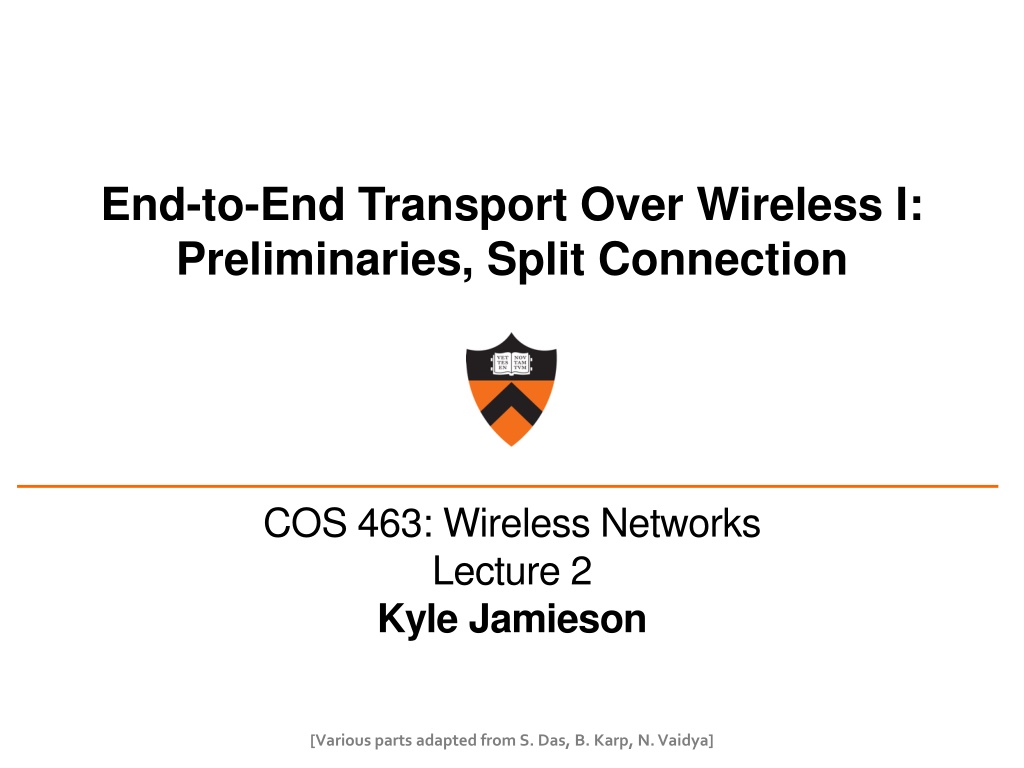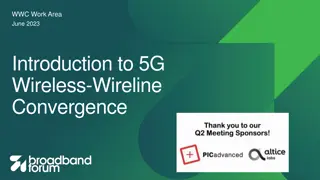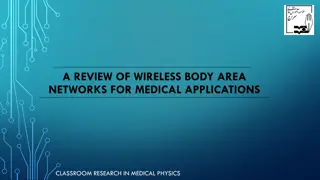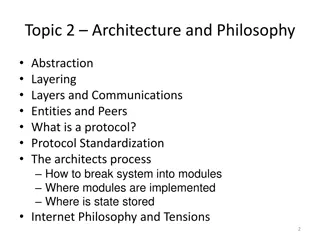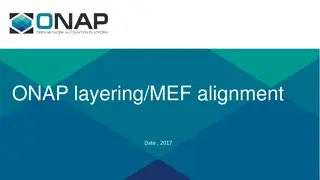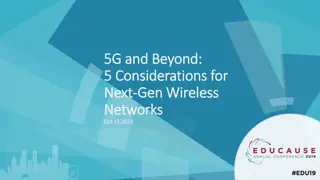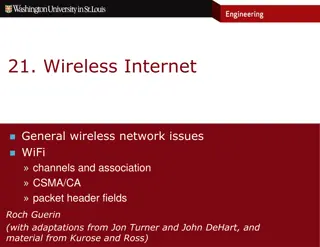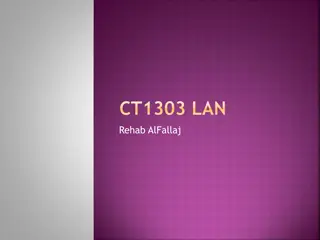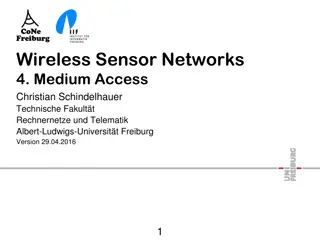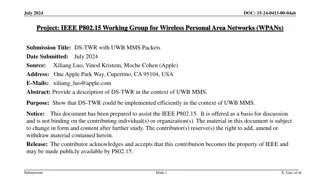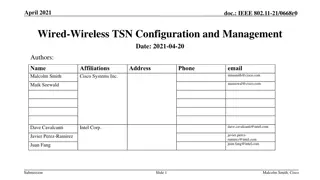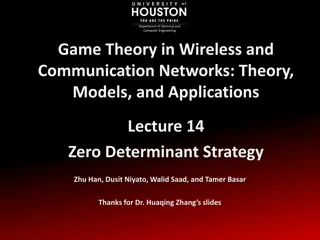Understanding Layering in Wireless Networks
This content delves into the concept of layering in wireless networks, highlighting the motivation behind layering, the Internet's approach to avoiding reimplementation for each underlying medium, the role of intermediate layers in providing abstractions, properties of network layers, and the functions of the physical and data link layers. It discusses the services, interfaces, and protocols involved in ensuring efficient communication between Internet hosts.
Download Presentation

Please find below an Image/Link to download the presentation.
The content on the website is provided AS IS for your information and personal use only. It may not be sold, licensed, or shared on other websites without obtaining consent from the author. Download presentation by click this link. If you encounter any issues during the download, it is possible that the publisher has removed the file from their server.
E N D
Presentation Transcript
End-to-End Transport Over Wireless I: Preliminaries, Split Connection COS 463: Wireless Networks Lecture 2 Kyle Jamieson [Various parts adapted from S. Das, B. Karp, N.Vaidya]
Today 1. Layering and the End-to-End Argument 2. Transmission Control Protocol (TCP) primer 3. Split Connection TCP over wireless 2
Layering: Motivation Web FTP Skype SSH Applications ? Transmission media Coaxial cable Fiber optic Wi-Fi Re-implementevery application for every new underlying transmission medium? Change every application on any change to an underlying transmission medium (and vice-versa)? No! But how does the Internet design avoid this? 3
Internet solution: Intermediate layers HTTP FTP Skype SSH Applications Intermediate layers Transmission media Coaxial cable Fiber optic Wi-Fi Intermediate layers provide a set of abstractions for applications and media New applications or media need only implement for intermediate layer s interface 4
Properties of layers Application Transport Network Link Physical Service:What a layer does Service interface:How to access the service Interface for the layer above Protocol interface:How peers communicate to implement service Set of rules and formats that govern the communication between two Internet hosts 5
Physical layer (L1) Service: Move bits between two systems connected by a single physical link Interface: specifies how to send, receive bits e.g., require quantities and timing Protocols: coding scheme used to represent bits, voltage levels, duration of a bit 6
Data link layer (L2) Service: End hosts exchange atomic messages Perhaps over multiple physical links But using same framing (headers/trailers) Arbitrates access to common physical media Implements reliable transmission, flow control Interface: send messages (frames) to other end hosts; receive messages addressed to end host Protocols: Addressing, routing, medium access control 7
Network layer (L3) Service: Deliver datagrams to other networks Cross-technology (e.g., Ethernet, 802.11, optical, ) Possibly includes packet scheduling/priority Possibly includes buffer management Best effort service: may drop, delay, duplicate datagrams Interface: Send packets to specified internetwork destination Receive packets destined for end host Protocols: Define inter-network addresses (globally unique) Construct routing tables and forward datagrams 8
Transport layer (L4) Service: Provide end-to-end communication between processes on different hosts Demultiplex communication between hosts Possibly reliability in the presence of errors Rate adaptation (flow control, congestion control) Interface: send message to specific process at given destination; local process receives messages sent to it Protocol: perhaps implement reliability, flow control, packetization of large messages, framing 9
Who does what? Five layers Lower three layers are implemented everywhere Top two layers are implemented only at end hosts Their protocols are end-to-end Application Transport Network Link Physical Host A Application Transport Network Link Physical Host B Network Link Physical Router 10
Logical communication Each layer on a host interacts with its peerhost s corresponding layer via the protocol interface Application Transport Network Link Physical Host A Application Transport Network Link Physical Host B Network Link Physical Router 11
Physical path across the Internet Communication goes down to physical network Then from network peer to peer Then up to the relevant layer Application Transport Network Link Physical Host A Application Transport Network Link Physical Host B Network Link Physical Router 12
Protocol multiplexing Multiplexing: Multiple overlying protocols share use of a single underlying protocol Problem: How does the underlying protocol decide which overlying protocol messages go to? Applications Applications TCP TCP UDP UDP ??? Network Network Host A Host B 13
Protocol headers Each layer attaches its own header (H) to facilitate communication between peer protocols On reception, layer inspects and removes its own header Higher layers don t see lower layers headers data Application Transport Network Link Physical Application Transport Network Link Physical data data H H H HH H HHHH data data H data data H data H HH data H HHHH data Host A Host B 14
Encapsulation in the Internet data data data data message segment datagram H frame HH HHHH data frame application transport network link physical H H H Host A link HH data H HH data H HHHH data physical application transport network link physical data data data data H H H L2 Switch Host B H HH HHHH data H data network link physical H data data H H H HH HHHH data L3 Router 15
Protocol demultiplexing data data data message segment datagram H application transport network H H Host A application transport network data data H H Applications Host B H TCP UDP ??? Network Lower-layer header contains demultiplexing information Host B Network header contains Protocol field specifying overlying protocol 16
Drawbacks of layering Layer n may duplicate lower level functionality e.g., error recovery to retransmit lost data Layers may need same information in headers e.g., timestamps, maximum transmission unit size Layering can hurt performance e.g., previous lecture 17
Layer violations Two types: 1. Overlying layer examines underlyinglayer s state e.g., transport monitors wireless link-layer to see whether packet loss from congestion or corruption 2. Underlying layer inspecting overlyinglayer s state e.g., firewalls, NATs (network address translators), transparent proxies 18
Today 1. Layering and the End-to-End Argument Reading: End-to-End Arguments in System Design by Saltzer, Reed, Clark 2. Transmission Control Protocol (TCP) primer 3. Split Connection TCP over wireless 19
Motivation: End-to-End Argument Five layers in the Internet architecture model Five places to solve many of same problems: In-order delivery Duplicate-free delivery Reliable delivery after corruption, loss Encryption Authentication In which layer(s) should a particular function be implemented? 20
Example: Careful file transfer from A to B data A B LL ACKs Goal: Accurately copy file onA s storagetoB s storage Straw man design: Read file from A s storage A sends packetized file to B Link layer resends lost or corrupted packets at each hop B writes file data to storage Does this system meet the design goal? Bit errors on links no issue 21
Where might errors happen? On A s or B s disk In A s or B s RAM or CPU In A s or B s software In the RAM, CPU, or software of any router that forwards packet Why might errors be likely? Drive for CPU speed and storage density: pushes hardware to EE limits, engineered to tight tolerances e.g., today s disks return data that are the output of an maximum-likelihood estimation! Bugs abound! 22
Solution: End-to-End verification 1. A keeps a checksum with the on-disk data Why not compute checksum at start of transfer? 2. B computes checksum over received data, sends to A 3. A compares the two checksums and resends if not equal Can we eliminate hop-by-hop error detection? Is a whole-file checksum, alone, enough? 23
End-to-End Principle Only the application at communication endpoints can completely and correctly implement a function Processing in middle alone cannot provide function Processing in middlemay, however, be an importantperformance optimization Engineering middle hops to provide guaranteed functionality is oftenwasteful of effort, inefficient 24
Perils of lower-layer implementation Entangles application behavior with network internals Suppose each IP router reliably transmitted to next hop Result: Lossless delivery, but variable delay ftp: Okay, move huge file reliably (just end-to-end TCP works fine, too, though) Skype: Terrible, jitter packets when a few corruptions or drops not a problem anyway Complicates deployment of innovative applications Example: Phone network v. the Internet 25
Advantages of lower-layer implementation Can improve end-to-end system performance Each application author needn t recode a shared function Overlapping error checks (e.g., checksums) at all layers invaluable in debugging and fault diagnosis If end systems not cooperative (increasingly the case), only way to enforce resource allocation! 26
End-to-end violation: Firewalls Firewall Internet Our network St%2520Patrick%2520Worm X Firewalls clearly violate the e2e principle Endpoints are capable of deciding what traffic to ignore Firewall is entangled with network, transport, apps, & vice-versa e.g.:New header bit to improve congestion control? Many firewalls filter all such packets! Yet, we probably do need firewalls 27
Summary: End-to-End principle Many functions must be implemented at application endpoints to provide desired behavior Even if implemented in middle of network End-to-end approach decouples design of components in network interior from design of applications at edges Some functions still benefit from implementation in network interior at cost of entangling interior, edges End-to-end principle is not sacred;it s just a way to think critically about design choices in communication systems 28
Five-minute break and Partner Exercises 1. The end-to-end argument is: A. A guideline for placing functions in computer systems B. A rule for placing functions in a computer system C. A debate on where to place functions in a computer system D. A debate about anonymity in computer networks 2. Of the following, the best example of an end-to-end argument is: A. If you laid all the web programmers in the world end to end, they would reach from Princeton to CERN B. Every byte going into the write end of a UNIX pipe eventually emerges from the pipe s read end C. Even if a chain manufacturer tests each link before assembly, they had better test the completed chain D. All important network communication functions should be moved to the Application layer 29
Today 1. Layering and the End-to-End Argument 2. Transmission Control Protocol (TCP) primer Over wired networks Reading: Congestion Avoidance and Control by Jacobson and Karels 3. TCP over wireless 30
TCP: Connection-Oriented, Reliable Byte Stream Transport Layer-four protocol for reliable transport Sending app offers a sequence of bytes: d0, d1, d2, Receiving app sees all bytes arrive in same sequence: d0, d1, d2 Result:Reliable byte stream transport between endpoints on the internet Each such byte stream is called a connection, or flow 31
TCPs Many End-to-End Goals Recover from data loss Avoid receipt of duplicated data Preserve data ordering Provide integrity against corruption Avoid sending faster than receiver can accept data Avoid congesting network 32
Fundamental Problem: Ensuring At-Least-Once Delivery Network drops packets, so to ensure delivery: Sender attaches sequence number (seqno) to each data packet sent; keeps copy of sent packet Receiver returns acknowledgement (ACK) to sender for each data packet received, containing seqno Sender sets a retransmittimeron each transmission If timer expires < ACK returns: retransmit that packet If ACK returns, cancel timer, forget that packet How long should the retransmit timer be? 33
Fundamental Problem: Estimating RTT Expected time for ACK to return is round-trip time (RTT) End-to-end delay for data to reach receiver, then its ACK to reach sender Strawman: use fixed timer (e.g., 250 milliseconds) What if the route/wireless conditions change? What if congestion occurs at one or more routers? Fixed timer violates E2E argument; details of link behavior should be left to link layer! Hard-coded timers lead to brittle behavior as technology evolves Too small a value: needless retransmissions Too large a value: needless delay detecting loss 34
Estimating RTT: Exponentially Weighted Moving Average (EWMA) Measurements of RTT readily available Note time t when packet sent, corresponding ACK returns at time t RTT measurementsample: m= t t EWMA weights newest samples most Single sample too brittle (queuing, routing dynamic) How to choose ? (TCP uses 1/8) Is mean sufficient to capture RTT behavior over time? (more later) Adapt over time, using EWMA: Measurement samples:m0, m1, m2, fractional weight for new measurement, RTTi= ((1 ) RTTi-1 + mi) 35
What is Congestion? Sources may have sufficient proximal link capacity to send But in the middle of the network may share capacity Too many packets in the network queue overflows: congestion 36
How does TCP know congestion occurred? How can packets get lost in wired networks? Almost exclusively queue buffer overflows Packet loss is a binary signal How does a TCP sender know that a packet loss has occurred? Lack of receipt of an Acknowledgement Timeouts 37
Retransmission and Duplicate Delivery When sender s retransmit timer expires, two indistinguishable cases: Data packet dropped en route to receiver, or ACK dropped en route to sender In both cases, sender retransmits In latter case, duplicate data packet reaches receiver! 38
Eliminating Duplicates: Exactly-Once Delivery Sender marks each packet with a monotonically increasing sequence number seqno Sender includes greatest ACKed seqno in its packets Receiver remembers only greatest received sequence number, drops received packets with smaller ones Doesn t guarantee delivery! Properties: If delivered, then only once. If undelivered, sender will not think delivered. If ACK not seen, data may have been delivered, but sender will not know. 39
End-to-End Integrity Achieved by using transport checksum Protects against things link-layer reliability cannot: Router memory corruption, software bugs, &c. Covers data in packet, transport protocol header Also should cover layer-3 source and destination! Misdelivered packet should not be inserted into data stream at receiver, nor should be acknowledged Receiver drops packets w/failed transport checksum 40
Today 1. Networking primer/review 2. Transmission Control Protocol (TCP) primer 3. TCP over wireless 41
Running TCP on Wireless Links Generally, TCP interprets packet loss as queue congestion TCP sender reduces congestion window Wireless links have higher bit error rates, frame loss rates On wireless links, packet loss can also occur due to random channel errors, or cellular or WLAN handoffs Temporary loss not due to congestion Reducing window may be too conservative Leads to poor throughput 42
Wireless can also Cause Packet Loss Dave Cathy Alice Bob Shared wireless medium leads to a collision of Bob and Cathy s packets at Alice 43
Wired & Wireless Mix: Best TCP sender strategy becomes unclear Congestion loss Link loss Frequent (collision) Frequent Wireless link: (multipath, interference) Wired links: Frequent (queue drop) Rare ? loss loss Slow down! Maintain rate 44
Fundamental question: How to differentiate between 1. Loss due to congestion 2. Loss due to wireless link itself Hard to do: TCP is fundamentally an end-to-end protocol: only sees a loss 45
Two Broad Approaches 1. Maskwireless losses from TCP sender Then TCP sender will not slow down Split Connection Approach TCP Snoop 2. Explicitly notify TCP sender about cause of packet loss 46
Split Connection Approach Also called Indirect TCP (I-TCP) Divide the TCP connection into two parts: 1. TCP connection between content server and AP 2. Another connection between AP and mobile host No real end-to-end connection No changes to the TCP endpoint at the content server Access point (AP) Mobile Multi-hop Wired Internet Wireless (One hop) Content server 47
Split Connection: TCP Implementation Per-TCP connection state Application Transport Network Link Physical Application Transport Network Link Physical Application Transport Network Link Physical TCP Reliable transport Wireless link Maintain statefor both halves of each end-to-end connection at the AP 48
Split Connection: Considerations Connection between AP and mobile need not be TCP Could be e.g., Selective Repeat over UDP Assume that the wireless part is just one hop (traditional cellular or wireless LAN) Assumes wireless losses not caused by too many packets in the network But that s not always true (e.g. collisions) Sender should slow down, but doesn t 49
Split Connection: State Migration Consequence of breaking end-to-end connection: On handoff from AP 1 to AP 2, connection state must move from AP 1 to AP 2 AP 1 Content server Multi-hop Wired Internet Mobile Wireless (One hop) AP 2 50
